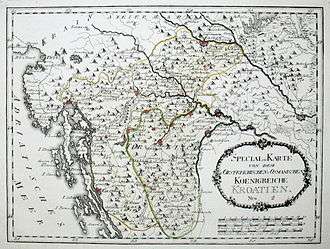Turkish Croatia

Turkish Croatia or Ottoman Croatia (Croatian: Turska Hrvatska, German: Türkisch Kroatien, Italian: Croazia turca, French: Croatie turque) was a part of the territory of the Croatian Kingdom occupied by the Ottoman Empire during the 15th and 16th century. By the 19th century, with the Croatian population mostly displaced, the name Turkish Croatia was replaced by cartographers in favor of Bosanska Krajina (Bosnian Frontier).
The territory of Turkish Croatia comprised the land area between three rivers – Vrbas in the east, Sava in the northeast, Una in the northwest – as well as Dinara mountain in the south, and including the Cazinska krajina pocket in the far west. This area is a part of the present-day state of Bosnia and Herzegovina.
History
During the Middle Ages and the very beginning of the Early modern period, the territory of Turkish Croatia was situated in the central and eastern part of the independent medieval Croatian state (from 925 known as Kingdom of Croatia), which lasted until the beginning of the 12th century, when the country, following the Pacta conventa agreement, entered into a personal union with Hungary in 1102. At that time the term „Bosnia“ was used for a relatively small area alongside the upper part of the Bosna river that barely reached the Drina. It was only in the 14th century, when Croatia was weakened, that the medieval Bosnian state under King Stjepan Tvrtko I grew in both, size and power, and eastern and southern parts of Croatia were subjected to Bosnian domination.
The fall of Bosnia to the Ottomans in 1463 resulted in increasing pressure on Croatian borders and continual losses of the territory, little by little moving the border line to the west. Permanent warfare during the Hundred Years' Croatian–Ottoman War (1493-1593) drastically reduced Croatian population in affected southeastern regions. Until the end of the 16th century the whole area of Turkish Croatia was occupied by the mighty sultanate. The remaining Croats were either murdered or captured, converted to Islam and recruited as devsirme (blood tax). A part of the Croatian population managed to flee though, settling down in the northwestern regions of the country or abroad, in the neighbouring Hungary or Austria. Catholic churches were destroyed by the Ottoman soldiers or reconstructed into mosques; some priests and bishops were killed, some of them succeeded in escaping.
From the 16th to 19th century Turkish Croatia bordered Croatian Military Frontier (Croatian: Hrvatska vojna Krajina, German: Kroatische Militärgrenze), a Habsburg Empire-controlled part of Croatia, which was administered directly from Vienna's military headquarters. In the 19th century, following the Habsburg-Ottoman war in 1878 and the fall of the Bosnia Vilayet, Turkish Croatia remained within the borders of Bosnia and Herzegovina, who 1908 became a new Crown land of the Habsburg Monarchy. Although the (recently renamed) old Croatian territory was liberated, there were very few Croatian population left, i.e. population who actually lived in it registered as Catholics and Croats.
Maps
of King Petar Krešimir IV (11th century): Turkish Croatia was in the center of the Kingdom |
 Bosnia in the 14th century (included parts of Croatia) |
 upper left part) on an 1827 map of the Ottoman conquest in Europe according to American cartographer A. Finley |
 of the Ottoman expansion in Bosnia and Croatia |
See also
- Ottoman period in the history of Croatia
- Timeline of Croatian history
- Donji Kraji
- Croats of Bosnia and Herzegovina
- Ottoman conquest of Bosnia and Herzegovina
- Bosnia Eyalet
- Demographic history of Bosnia and Herzegovina
External links
- Turkish Croatia – loss of southeastern Croatia to the Turks
- Fortresses in Turkish Croatia /page 56/ (in German)
- Geology books on Turkish Croatia from the 19th century (in Croatian)
- Cover of the August Kaznačić book „Bosnia, Herzegovina and Turkish Croatia“ from 1862 (in Italian)